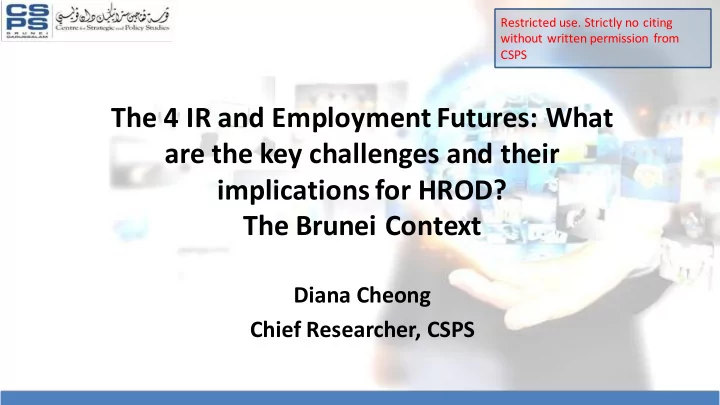

Restricted ¡use. ¡Strictly ¡no ¡citing ¡ without ¡written ¡permission ¡ from ¡ CSPS The ¡4 ¡IR ¡and ¡Employment ¡Futures: ¡What ¡ are ¡the ¡key ¡challenges ¡and ¡their ¡ implications ¡for ¡HROD? The ¡Brunei ¡Context Diana ¡Cheong Chief ¡Researcher, ¡CSPS
Brunei ¡Unemployment ¡Figure 9.3, ¡LFS ¡2017 Source: ¡ILO; ¡Brunei ¡2017 ¡data ¡is ¡from ¡LFS ¡2017 ¡and ¡ ¡individual ¡country ¡figures..
Brunei ¡Unemployment ¡Figures 11.5% ¡ 9.3% 31.7% ¡ Whole ¡population ¡ Whole ¡population ¡ 15 ¡to ¡24 ¡years ¡ (locals ¡only) (locals ¡+ ¡foreigners) (locals ¡only) Unemployment ¡Rate ¡ Labour ¡Underutilisation ¡Rate ¡ 23.1% 27% ¡(2014) 46.5% ¡(2014) Whole ¡population 15 ¡to ¡39 ¡years ¡ 15 ¡to ¡24 ¡years ¡ (locals ¡+ ¡foreigners ¡) (locals ¡only) (locals ¡only)
Why ¡do ¡we ¡have ¡an ¡quite ¡a ¡serious ¡unemployment ¡ problem ¡amongst ¡our ¡local ¡youth ¡when ¡a ¡large ¡% ¡ (nearly ¡30%) ¡of ¡our ¡workforce ¡consist ¡of ¡foreign ¡labour at ¡all ¡levels?
Study ¡No.1: ¡A ¡Study ¡of ¡Unemployment ¡Issues ¡among ¡Registered ¡Jobseekers ¡in ¡Brunei ¡ Darussalam ¡(2009) Main ¡Finding: ¡Early ¡school ¡leavers ¡with ¡only ¡2-‑3 ¡‘O’ ¡levels ¡who ¡do ¡not ¡have ¡enough ¡vocational ¡skills ¡for ¡ available ¡jobs. ¡Mainly ¡interested ¡in ¡clerical ¡and ¡lower ¡white ¡collar ¡office ¡jobs, ¡especially ¡in ¡ Government. ¡High ¡mismatch ¡between ¡available ¡skills ¡and ¡desired ¡employment. ¡Private ¡sector ¡jobs ¡are ¡ not ¡attractive ¡and ¡can ¡lack ¡in ¡good ¡HR ¡practices. Policy ¡Recommendations: 1. Increase ¡VTE, ¡expansion ¡of ¡tertiary ¡pathways ¡and ¡reduce ¡early ¡school ¡drop ¡outs. 2. Our ¡young ¡people ¡need ¡to ¡have ¡a ¡mindset ¡change, ¡be ¡more ¡productive ¡and ¡professional. 3. Encourage ¡Bruneians ¡toward ¡more ¡manual, ¡semi-‑skilled ¡and ¡skilled ¡jobs ¡especially ¡in ¡the ¡private ¡ sector ¡as ¡these ¡are ¡the ¡sectors ¡which ¡have ¡available ¡job ¡opportunities ¡(given ¡appropriate ¡employment ¡ policy ¡on ¡foreign ¡labour). ¡ 4. Private ¡sector ¡and ¡non ¡office ¡jobs ¡must ¡be ¡made ¡more ¡attractive ¡to ¡Bruneians, ¡better ¡HR ¡Practices ¡esp in ¡terms ¡of ¡better ¡financial ¡remuneration, ¡job ¡status, ¡career ¡progression ¡and ¡working ¡conditions ¡(Nb: ¡ Reservation ¡wage) 5. Professionalization ¡of ¡manual/crafts ¡jobs ¡like ¡electrician, ¡plumber ¡and ¡drivers ¡through ¡better ¡training, ¡ certification ¡of ¡skills ¡and ¡standards, ¡therefore ¡leading ¡to ¡higher ¡salaries. ¡ ¡As ¡the ¡status ¡of ¡such ¡jobs ¡ increases, ¡more ¡locals ¡will ¡be ¡encouraged ¡to ¡go ¡for ¡such ¡jobs ¡and ¡compete ¡with ¡foreigners.
“As ¡the ¡status ¡of ¡such ¡jobs ¡increases, ¡more ¡ locals ¡will ¡be ¡encouraged ¡to ¡go ¡for ¡such ¡jobs ¡ and ¡compete ¡with ¡foreign ¡labour”
Study ¡No.2: ¡Unemployment ¡Issues ¡among ¡University ¡Graduates ¡in ¡Brunei ¡Darussalam ¡(2014) Mismatch ¡between ¡university ¡degrees ¡and ¡labour demand: ¡graduates ¡in ¡Arts ¡and ¡Humanities ¡are ¡ • more ¡likely ¡to ¡remain ¡unemployed – Implications ¡regarding ¡scholarship ¡decisions Graduates ¡from ¡top ¡universities ¡are ¡more ¡likely ¡to ¡find ¡a ¡job ¡(also ¡compared ¡to ¡local ¡universities) • – Implications ¡regarding ¡scholarships ¡and ¡development ¡of ¡local ¡universities Significant ¡differences ¡between ¡ethnic ¡groups: ¡Malays ¡are ¡more ¡likely ¡to ¡wait ¡for ¡Govt jobs ¡and ¡ • do ¡passive ¡job ¡search – Implications ¡regarding ¡ ¡mindset ¡change ¡and ¡incentive ¡structures Married ¡women ¡are ¡more ¡likely ¡to ¡be ¡unemployed • – Implications ¡regarding ¡ ¡working ¡mother ¡policies ¡(creches, ¡nurseries, ¡childcare) Delayed ¡employment ¡and ¡long ¡unemployment ¡spells ¡affect ¡subsequent ¡employment ¡probability • – Need ¡for ¡active ¡labour market ¡policies ¡aimed ¡at ¡increasing ¡early ¡participation ¡and ¡improving ¡ job ¡search ¡efforts
Summary ¡of ¡manpower ¡planning/HRD ¡policies ¡to ¡reduce ¡unemployment 1. Improvement ¡of ¡childcare ¡facilities ¡for ¡women ¡to ¡enter ¡the ¡labour force. 2. Improvement ¡of ¡public ¡infrastructures ¡(eg transport/connectivity) ¡for ¡ ease ¡of ¡going ¡to ¡work. 3. Improvement ¡of ¡HR ¡practices/ ¡employment ¡regulations. 4. Relevant ¡education ¡and ¡expansion ¡of ¡VTE 5. Reducing ¡mismatch ¡between ¡job ¡preferences ¡and ¡actual ¡available ¡jobs 6. Reducing ¡the ¡disparities ¡in ¡the ¡labour market ¡by ¡improving ¡the ¡ attractiveness ¡of ¡the ¡more ¡manual ¡private ¡sector ¡occupations 7. Change ¡mindset ¡and ¡mentality ¡ 8. Need ¡to ¡provide ¡more ¡sustainable ¡and ¡attractive ¡job ¡opportunities.
Sustainable ¡HROD • HROD ¡consists ¡of ¡putting ¡right ¡people, ¡at ¡the ¡right ¡place, ¡right ¡time, ¡doing ¡ the ¡right ¡things ¡for ¡which ¡they ¡are ¡suited ¡for ¡the ¡achievement ¡of ¡goals ¡of ¡ the ¡organization. ¡ • Who ¡do ¡we ¡hire ¡and ¡how ¡do ¡we ¡retain ¡our ¡workers? • What ¡kind ¡of ¡work ¡environment ¡to ¡create ¡to ¡attract ¡and ¡retain ¡talents ¡that ¡ we ¡need? • Main ¡Factors ¡for ¡a ¡sustainable ¡work ¡culture: (i) ¡type ¡and ¡strategy ¡of ¡organization (ii) ¡environmental ¡uncertainties (iii) ¡time ¡horizons (iv) ¡labor ¡market.
Sustainable ¡HROD: ¡What ¡are ¡our ¡job ¡and ¡skills ¡futures? (i) ¡National ¡economic ¡strategy: ¡ Diversification, ¡10 ¡industrial ¡clusters, ¡niche ¡in ¡energy, ¡biodiversity, ¡ ¡ specialized ¡health, ¡halal. ¡Which ¡economic ¡path? (ii) ¡Environmental ¡uncertainties Technological ¡uncertainties, ¡resource ¡potentials, ¡environmental ¡challenges ¡ policy ¡uncertainty. (iii) ¡Time ¡horizons 5y, ¡10y ¡and ¡15y? (vi) ¡Labor ¡market Small ¡labour force, ¡reliance ¡on ¡foreign ¡labour, ¡ ¡Negative ¡mindset ¡& mentality ¡at ¡ALL ¡levels, ¡low ¡levels ¡and ¡mismatch ¡of ¡education ¡for ¡4.0 ¡IR
STEEP • S ocial • T echnology • E ducation • E conomy • P olitics
Educational ¡Scanning Educational ¡Attainment ¡ Brunei Singapore OECD ¡Countries 34.09% 1 84.1 ¡% 2 5 ¡O-‑Levels ¡and ¡more ¡(2016) -‑ 79.76% 1 2 ¡A-‑Levels ¡and ¡more ¡(2016) 92.6% (3 ¡A-‑Levels ¡& ¡ -‑ more) 2 30.862% ¡(2016) 1 70% ¡(2013) 2 72.776% 3 Tertiary ¡Enrollment ¡Rate ¡% ¡of ¡Gross ICT/STEM ¡Education ¡Enrollment ¡ 10% ¡enrolled -‑ 12.5% ¡enrolled ¡(2018) 5 HE: ¡36% ¡STEM ¡enrolled 1 (2016) 50% ¡STEM ¡enrolled ¡ (2011) 6 Source: ¡1. ¡MOE ¡Brunei ¡(2016) ¡Brunei ¡Darussalam ¡ Education ¡Statistics ¡and ¡Indicators ¡Handbook. ¡P220 2. ¡MOE ¡Singapore ¡(2018) ¡Education ¡Statistics ¡ Digest ¡2018. ¡P62 3. ¡UNESCO ¡Institute ¡for ¡Statistics ¡ (2018) ¡School ¡enrollment, ¡ tertiary ¡ (% ¡gross). ¡https://data.worldbank.org/indicator/SE.TER.ENRR?locations=BN-‑OE-‑8S 4. ¡MCYS ¡– CSPS ¡(2018) ¡Youth ¡Policy ¡ Survey 5. ¡Singapore ¡MOE ¡(2018) ¡Education ¡Statistics ¡ Digest, ¡Singapore ¡ 6. ¡Center on ¡International ¡Education ¡ Benchmarking. ¡(2012, ¡July ¡31). ¡NCEE ¡statistic ¡ of ¡the ¡month: ¡investigating ¡ the ¡skills ¡mismatch. ¡Retrieved ¡from ¡www.ncee.org/2012/07/statistic-‑of-‑the-‑month-‑investigating-‑ the-‑skills-‑mismatch/
Recommend
More recommend